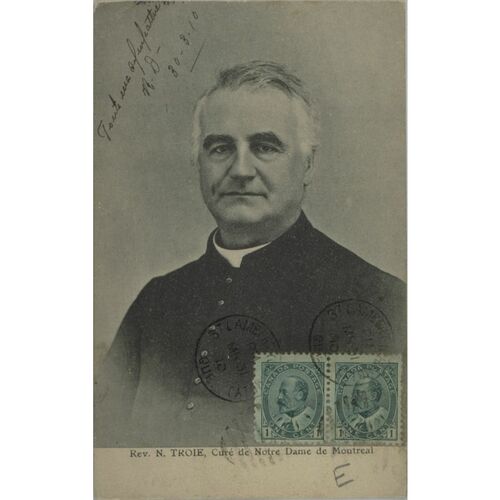TROIE, NARCISSE-AMABLE, Roman Catholic priest, Sulpician, professor, and superior; b. 3 April 1843 in Saint-Rémi-de-La Salle (Saint-Rémi), Lower Canada, son of Amable Troie, dit Lafranchise, a farmer, and Marie Pinsonneau (Pinsonneault); d. 15 March 1919 in Montreal.
After primary schooling in Saint-Rémi-de-La Salle and at the Petit Séminaire de Montréal in 1855, Narcisse-Amable Troie began classical studies at the latter institution; in 1864 he entered the Grand Séminaire de Montréal. Just after becoming a subdeacon, he left for Paris in February 1867 with the superior, Joseph-Alexandre Baile*, and there he completed his education at the Séminaire de Saint-Sulpice. He was ordained priest on 6 June 1868, following a year at the solitude (noviciate) in Issy-les-Moulineaux.
On his return to Montreal in August, Troie was appointed professor of philosophy at the Petit Séminaire de Montréal. He taught scholastic philosophy to the two senior classes, which ranged in number from 21 students in 1868–69 to 35 in 1875–76; he used a three-volume textbook written in Latin by Sulpician Jacques Manier and prescribed by Bishop Ignace Bourget*. In 1875 Troie was appointed to the Grand Séminaire, where he lectured on apologetics for five years and moral philosophy for another five. He was an excellent teacher. Unfortunately, after 17 years in the classroom, he had to resign in 1885 because of throat ailments. He was then named curate of Saint-Jacques, where with nine other Sulpicians he devoted himself to the parishioners. Troie was in charge of various organizations, including the Congrégation des Hommes de l’Immaculée Conception, a confraternity affiliated with that of the Jesuits in Rome, and he also gave direction to several English-language parish groups. In 1894 he became the priest.
On 12 March 1895 Troie was appointed to the same post for Notre-Dame parish in Montreal, which had been served by the Sulpicians since 1657. It was densely populated and the number of businesses in it was slowly increasing. As at Saint-Jacques, Troie regretted that administrative tasks distanced him from parishioners. He had 10 curates or chaplains to help him; by 1913 he had 15. They taught catechism in the primary schools, led confraternities, visited the sick, and helped the poor. Two priests took care of services at Notre-Dame-de-Bonsecours chapel, which Marguerite Bourgeoys* had erected in 1675. Troie represented Saint-Sulpice on the council of the Université Laval in Montreal. Like his predecessors Benjamin-Victor Rousselot* and Léon-Alfred Sentenne, Father Troie maintained and added to the church buildings, buying four other properties in Côte-des-Neiges and having access roads built in Notre-Dame-des-Neiges cemetery. He was an especially prudent administrator. On his arrival he found there was a debt of $203,000. The fabrique spent $418,000 during the 18 years he served it and when he left in 1913 the debt had been reduced to $111,000.
Troie retired in 1913 a sick man. Four years later, although he had not completely recovered, he was elected superior of the Séminaire de Saint-Sulpice in Montreal, becoming the first Canadian to hold this office. He was surprised at the choice – he was 74 years old – but he threw himself into the task with resolve. The seminary had radically changed since the 1860s. Under Louis-Frédéric Colin*, its superior from 1881 to 1902, cordial relations had been developed with Archbishop Edouard-Charles Fabre* of Montreal. Throughout the 19th century the majority of Sulpicians at the seminary had been from France, a situation that engendered some resentment among those from Canada; by 1900 the community included 38 Canadians and 34 Frenchmen, and by 1915 there were 45 Canadians and 34 French. Troie was successful in his efforts to maintain harmony within the Montreal community. His health, however, deteriorated and he died quite suddenly of a heart attack on 15 March 1919.
In a tribute to Troie just after his death, Henri-Pierre Garriguet, the superior general of Saint-Sulpice, observed, “From the first glimpse, his physiognomy was remarkably attractive because of his beautiful crown of white hair, the majestic carriage of his head, the delicacy of his features, the solemn quality of his voice . . . [his was] a clear, precise mind, a heart inclined to kindliness, but without weakness.” Narcisse-Amable Troie was missed wherever Saint-Sulpice was known.
ANQ-M, CE1-32, 3 avril 1843. Arch. du Séminaire de Saint-Sulpice (Montréal), Carnets de N.-A. Troie, 1906–19. [Since Troie numbered all of the pages, it is apparent that he removed several which concerned controversial matters. b.h.] [Pierre] Boisard, La Compagnie de Saint-Sulpice; trois siècles d’histoire (s.l., s.d.). Le diocèse de Montréal à la fin du dix-neuvième siècle . . . (Montréal, 1900). Olivier Maurault, La paroisse: histoire de l’église Notre-Dame de Montréal (Montréal et New York, 1929); Saint-Jacques de Montréal: l’église, la paroisse (Montréal, 1923).
Cite This Article
Bruno Harel, “TROIE, NARCISSE-AMABLE,” in Dictionary of Canadian Biography, vol. 14, University of Toronto/Université Laval, 2003–, accessed December 4, 2025, https://www.biographi.ca/en/bio/troie_narcisse_amable_14E.html.
The citation above shows the format for footnotes and endnotes according to the Chicago manual of style (16th edition). Information to be used in other citation formats:
| Permalink: | https://www.biographi.ca/en/bio/troie_narcisse_amable_14E.html |
| Author of Article: | Bruno Harel |
| Title of Article: | TROIE, NARCISSE-AMABLE |
| Publication Name: | Dictionary of Canadian Biography, vol. 14 |
| Publisher: | University of Toronto/Université Laval |
| Year of publication: | 1998 |
| Year of revision: | 1998 |
| Access Date: | December 4, 2025 |


![Rev. N. Troie [image fixe] Original title: Rev. N. Troie [image fixe]](/bioimages/w600.7049.jpg)

